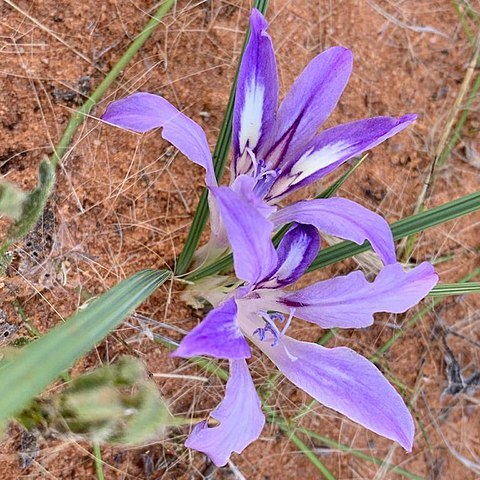Stemless, cormous geophyte, 50-150 mm tall, occasionally branched. Leaves linear to falcate or sword-shaped, often inclined to prostrate, lightly pleated, sparsely to finely long hairy, exceeding the flowers. Flowers 2-6 in an underground spike, bilabiate, greenish yellow to buff, flushed brown to mauve outside, sweetly scented, perianth tube emerging from below ground, cylindrical, 30-40 mm long, dorsal tepal 35-42 mm long, ovary smooth, bracts membranous below, green above ground, smooth, inner forked apically, tips attenuate. Mainly June-Sept.
Flowers usually pale to dark-blue to mauve (rarely white), with a strong sweet spicy fragrance, zygomorphic, the lower lateral tepals each with a whitish streak in the midline; perianth tube 35–55 mm long, narrowly infundibuliform; tepals lanceolate, acute, the outer 3 or sometimes all tepals mucronate, 25–60 × 6–12(15) mm, the 3 upper slightly longer than the lower ones.
A herb. It grows 12-20 cm high. It can form clumps. The corms are 2-3 cm across. The neck is 6-20 cm long. There are 4-7 leaves. They are erect. They are 7-20 cm long by 3-10 mm wide. The flower spike has 2-8 flowers congested on it. It comes from below the ground. The flowers are blue. They have a sweet spicy smell.
Spike congested, 2–8-flowered, arising below ground; outer bracts green, 2.5–4(8) cm long, lanceolate, acuminate, scarious and ferruginous apically, inner bracts similar but slightly shorter and bifid at the apex.
Foliage leaves usually 4–7, erect or suberect, overtopping the flowers, 7–20(30) cm long, 3–10 mm wide, linear or lanceolate, laxly to deeply plicate, glabrous, hispidulous or pilose on the ribs.
Corms 2–3 cm in diameter, globose; tunics thickly matted, coarsely fibrous and tough, with a neck 6–20 cm long.
Style branching at or beyond the anther apices, the branches 5–7 mm long.
Stamens unilateral and arcuate, 10–15 mm long; anthers 8–10 mm long.
Stem subterranean, simple or branched below ground.
Plants 12–20 cm high, sometimes forming clumps.
Capsules globose-oblong.

